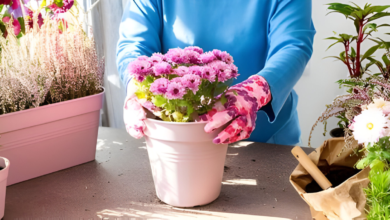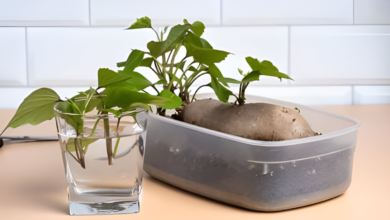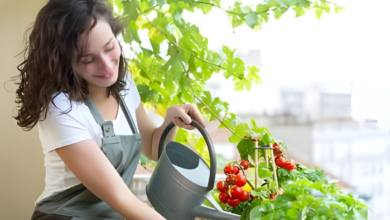The Benefits of Self-Watering Systems for Outdoor Potted Plants

Table of Contents:
- Introduction
- Understanding Self-Watering Systems
- Advantages of Self-Watering Systems
- Choosing the Right Self-Watering System
- Installation and Set-Up Process
- Maintenance Tips for Self-Watering Systems
- Impact on Plant Health
- Conserving Water with Self-Watering Systems
- Enhancing Convenience in Plant Care
- Cost Considerations and ROI
Introduction
I have always enjoyed having outdoor potted plants to enhance my living space, but the challenge of keeping them properly watered during hot summer days or when I’m away on vacation can be daunting. This is where self-watering systems come to the rescue, offering a convenient and efficient solution to ensure that my plants receive the right amount of water at all times.
Self-watering systems are designed to mimic the natural way plants absorb moisture, providing a consistent level of hydration without the risk of overwatering or underwatering. By utilizing a reservoir that holds excess water, these systems allow plants to draw moisture through capillary action as needed, promoting healthier root development and overall plant growth.
One of the key benefits of self-watering systems is the time and effort they save me in terms of frequent watering. With a busy schedule, I can rest assured that my plants are being taken care of, even during periods when I may not be able to attend to them regularly.
Furthermore, self-watering systems help prevent water wastage by delivering water directly to the plant’s roots, minimizing evaporation and runoff. This not only conserves water but also promotes a more sustainable approach to plant care.
In this article, I will delve into the various benefits that self-watering systems offer for outdoor potted plants, including improved plant health, water efficiency, convenience, and versatility. By incorporating these systems into my gardening routine, I have experienced firsthand the positive impact they can have on the well-being of my plants and the ease of maintenance they provide.
Understanding Self-Watering Systems
I have found that understanding self-watering systems is crucial for efficiently caring for outdoor potted plants. These systems work by providing a reservoir of water at the bottom of the pot, allowing the plant to absorb water as needed through capillary action. It’s essential to grasp how these systems function to take full advantage of their benefits.
- Reservoir Function: Self-watering systems have a reservoir that stores water, ensuring a constant supply for the plant. This reservoir prevents overwatering by allowing the plant to absorb only the water it requires.
- Capillary Action: Through capillary action, the plants draw up water from the reservoir into the soil as needed. This mimics the natural process by which plants absorb water from the ground, promoting healthier root development.
- Controlled Watering: Self-watering systems provide a controlled watering mechanism. They prevent waterlogging, root rot, and underwatering, as the plant can access water whenever it needs it.
- Efficiency: Understanding how self-watering systems operate leads to more efficient plant care. By knowing how much water the reservoir holds and how quickly the plant consumes it, I can adjust my watering schedule accordingly.
- Plant Autonomy: These systems give the plants a degree of autonomy in water uptake. I find it beneficial to trust the self-watering system to deliver water as needed, especially when I am unable to tend to my plants daily.
In conclusion, comprehending self-watering systems is essential for effectively utilizing them in maintaining outdoor potted plants. By grasping the reservoir function, capillary action, controlled watering, efficiency, and plant autonomy aspects, I can ensure that my plants receive the ideal amount of water for healthy growth and vitality.
Advantages of Self-Watering Systems
I enjoy the convenience and efficiency that self-watering systems bring to caring for my outdoor potted plants. Here are some key advantages that I have observed:
- Consistent Moisture Levels: With a self-watering system, plants receive a consistent amount of water. This helps in preventing under or over-watering, which can be detrimental to the plant’s health.
- Reduced Watering Frequency: Self-watering systems have reservoirs that hold water, allowing plants to draw water as needed. This feature reduces the frequency of watering, making it convenient, especially during hot summers or when I am away from home.
- Promotes Healthy Root Growth: By providing a steady moisture supply, self-watering systems encourage plants to develop strong and healthy roots. This leads to better overall growth and plant vigor.
- Minimizes Water wastage: Since the water is delivered directly to the plant’s roots, there is less evaporation and runoff, leading to water conservation. I appreciate this eco-friendly aspect of self-watering systems.
- Prevents Water Stress: Plants are less likely to experience water stress with a self-watering system. This is particularly beneficial during extreme weather conditions, ensuring that my plants remain healthy and thriving.
- Easy to Use and Maintain: Self-watering systems are typically easy to set up and require minimal maintenance. I find this simplicity convenient for seamlessly integrating them into my plant care routine.
- Suitable for Various Plant Types: Whether I have flowering plants, herbs, or succulents, self-watering systems are versatile and can cater to the watering needs of a wide range of plant varieties.
In my experience, self-watering systems offer a host of benefits that make plant care more manageable and enjoyable.
Choosing the Right Self-Watering System
When selecting a self-watering system for your outdoor potted plants, there are a few key factors to consider to ensure the optimal growth and health of your plants.
- Size of the Planter:
- Consider the size of your planters as this will determine the water reservoir capacity needed. Larger planters will require a system with a larger reservoir to adequately supply water to the plants.
- Plant Type:
- Different plants have varying water requirements. Choose a self-watering system that allows for adjustment of watering frequency or one that suits the specific needs of the plants you are growing.
- Climate:
- Take into account the climate in your area. If you live in a hot and dry region, you may need a self-watering system that can provide more frequent watering to combat the evaporation rate.
- Material:
- Self-watering systems come in a variety of materials such as plastic, ceramic, or clay. Consider the aesthetic appeal, durability, and insulation properties of the material when selecting a system.
- Ease of Use:
- Look for a system that is easy to set up and maintain. Some systems may have features like water level indicators or easy access for refilling the reservoir, which can make your gardening experience more convenient.
- Budget:
- Determine your budget for a self-watering system. There are options available at various price points, so it is important to find a system that meets your requirements without breaking the bank.
By considering these factors, you can choose the right self-watering system that will help your outdoor potted plants thrive with minimal effort on your part.
Installation and Set-Up Process
Setting up a self-watering system for your outdoor potted plants is a straightforward process that can offer great convenience and plant care benefits. Here is a step-by-step guide to installing and setting up your self-watering system:
- Choose the Right System: Select a self-watering system that suits the size and type of your outdoor pots. Options range from simple self-watering stakes to more advanced systems with reservoirs or drip irrigation.
- Prepare the Pot: Ensure your outdoor pot has drainage holes at the bottom. This is essential for proper water circulation and to prevent waterlogging.
- Insert the Watering Tool: If you are using self-watering stakes, insert them into the soil near the plant’s roots. For reservoir systems, place the reservoir in the pot according to the manufacturer’s instructions.
- Fill the Reservoir: If your system has a water reservoir, fill it with water through the designated opening. Make sure not to overfill to avoid water overflow.
- Adjust the Watering Schedule: Depending on your plant’s watering needs and the system you have chosen, adjust the watering frequency and duration. Monitor the soil moisture to find the right balance.
- Test the System: After set-up, test the self-watering system to ensure proper functioning. Check for any leaks, clogs, or malfunctions that may need troubleshooting.
By following these steps, you can efficiently install and set up a self-watering system for your outdoor potted plants. This process will help maintain optimal moisture levels for your plants, promoting healthier growth and reducing the need for constant monitoring and watering.
Maintenance Tips for Self-Watering Systems
When it comes to maintaining self-watering systems for outdoor potted plants, there are a few key tips to keep in mind to ensure they function effectively:
- Monitor water levels regularly: Check the water reservoir in your self-watering system frequently to ensure it is adequately filled. This will help prevent your plants from drying out.
- Clean the system periodically: It is important to clean the self-watering system every few weeks to prevent clogs and algae buildup. Use a mild soap and water solution to clean both the reservoir and the watering mechanism.
- Inspect for clogs: Regularly inspect the watering mechanism for any clogs or blockages that may affect the system’s performance. Clear any obstructions to ensure proper water flow to your plants.
- Adjust watering frequency: Depending on the weather conditions and plant needs, you may need to adjust the watering frequency of your self-watering system. During hot and dry periods, plants may require more frequent watering.
- Regularly fertilize your plants: While self-watering systems provide plants with moisture, they do not supply nutrients. It is essential to regularly fertilize your plants to ensure they receive the necessary nutrients for healthy growth.
- Check for leaks: Inspect the self-watering system for any leaks or water seepage. Addressing leaks promptly will help prevent water wastage and potential damage to your plants or surrounding areas.
By following these maintenance tips, I can ensure that my self-watering system continues to provide my outdoor potted plants with the proper amount of hydration and care they need for thriving growth.
Impact on Plant Health
I have found that self-watering systems have a significant positive impact on the health of outdoor potted plants. Here are a few reasons why these systems are beneficial for the plants:
- Consistent moisture levels: With a self-watering system, plants receive a consistent supply of water, which is crucial for their health. This helps prevent issues such as underwatering or overwatering, which can both be detrimental to plant health.
- Prevention of root rot: One common issue with traditional watering methods is the risk of root rot due to waterlogging. Self-watering systems allow for better drainage, reducing the likelihood of roots sitting in water for extended periods.
- Promotion of deep root growth: By ensuring that plants have access to water as needed, self-watering systems promote deep root growth. Deep roots help plants absorb nutrients more efficiently and provide better stability during adverse weather conditions.
- Increased resilience to drought: The consistent moisture provided by self-watering systems helps plants build resilience against drought conditions. This is especially beneficial for outdoor plants subjected to fluctuating weather patterns.
- Reduced stress on plants: Overall, self-watering systems reduce the stress on plants caused by inconsistent watering schedules. This results in healthier, happier plants that are more likely to thrive and bloom.
In conclusion, the impact of self-watering systems on plant health is undeniable. By providing the right amount of water at the right time, these systems contribute to the overall well-being and vitality of outdoor potted plants.
Conserving Water with Self-Watering Systems
I appreciate the importance of conserving water, especially in outdoor gardening. Implementing self-watering systems for my potted plants has been a game-changer in this regard. Here are some benefits of using self-watering systems for outdoor potted plants:
- Efficient Water Usage: Self-watering systems deliver water directly to the plant’s roots, minimizing water wastage through evaporation or runoff. This targeted approach ensures that the plants receive just the right amount of water they need, promoting healthier growth while conserving water.
- Reduced Frequency of Watering: With a self-watering system in place, I can water my outdoor potted plants less frequently. These systems have reservoirs that store excess water, providing a constant supply to the plants as needed. This feature not only saves me time and effort but also reduces water consumption.
- Prevention of Overwatering: Overwatering is a common issue that can lead to root rot and other plant diseases. Self-watering systems help prevent overwatering by maintaining optimal soil moisture levels. By delivering water gradually and as required, these systems promote better plant health and vitality.
- Suitable for Busy Lifestyles: As someone with a busy schedule, I find self-watering systems to be a convenient solution for keeping my outdoor potted plants healthy. These systems ensure that my plants are watered consistently, even when I am away from home for extended periods. It provides me with peace of mind knowing that my plants are being taken care of effectively.
Incorporating self-watering systems into my outdoor gardening routine has not only improved the health and growth of my potted plants but has also made water conservation a priority in my gardening practices.
Enhancing Convenience in Plant Care
I find that self-watering systems greatly enhance the convenience of caring for outdoor potted plants. Here are some key points to consider:
- Consistent Moisture Levels: With a self-watering system, I can ensure that my plants receive a consistent level of moisture. This feature is particularly beneficial during hot summer months or when I am away from home for a few days.
- Reduced Maintenance: By using a self-watering system, I can reduce the frequency of manual watering. This not only saves me time but also eliminates the risk of overwatering or underwatering my plants.
- Optimal Watering Technique: These systems are designed to water plants from the bottom up, encouraging healthy root growth. I appreciate that this technique mimics the natural watering process and promotes better overall plant health.
- Flexibility: Self-watering systems offer me flexibility in my watering routine. I can adjust the watering frequency based on the specific needs of each plant, giving me peace of mind that they are receiving the right amount of water.
- Suitable for Busy Lifestyles: For individuals with busy schedules, self-watering systems are a game-changer. I no longer have to worry about forgetting to water my plants, as the system takes care of this task for me.
In conclusion, self-watering systems not only simplify plant care but also contribute to healthier and more vibrant outdoor potted plants. I highly recommend incorporating these systems into your gardening routine for added convenience and peace of mind.
Cost Considerations and ROI
When considering the implementation of a self-watering system for outdoor potted plants, there are several cost factors to take into account. While the initial investment may seem higher compared to traditional watering methods, the long-term benefits often outweigh the upfront expenses. Here are some key points to consider in terms of cost and return on investment (ROI):
- Initial Cost: The cost of purchasing self-watering containers or installing a self-watering system can vary depending on the size of the area and the type of system chosen. While this initial cost may be higher than traditional watering methods, the efficiency and convenience of self-watering systems can result in savings in the long run.
- Water Savings: Self-watering systems are designed to water plants only when needed, minimizing water wastage. By using sensors or self-regulating mechanisms, these systems ensure that plants receive the right amount of water, reducing water consumption and potentially lowering water bills in the process.
- Time Savings: One of the significant benefits of self-watering systems is the time saved on manually watering plants. For busy individuals or those with extensive outdoor plant arrangements, the automation provided by self-watering systems can be invaluable. This time savings can translate into increased productivity or relaxation, depending on your priorities.
- Plant Health and Longevity: By providing plants with consistent and adequate water supply, self-watering systems can improve plant health and overall longevity. Healthy plants are more resistant to diseases and pests, reducing the need for costly treatments or replacements.
Overall, the cost considerations of implementing a self-watering system for outdoor potted plants must be viewed in terms of the long-term benefits they offer. While there may be initial expenses involved, the savings in time, water, and potential plant replacement costs can lead to a significant return on investment over time.




